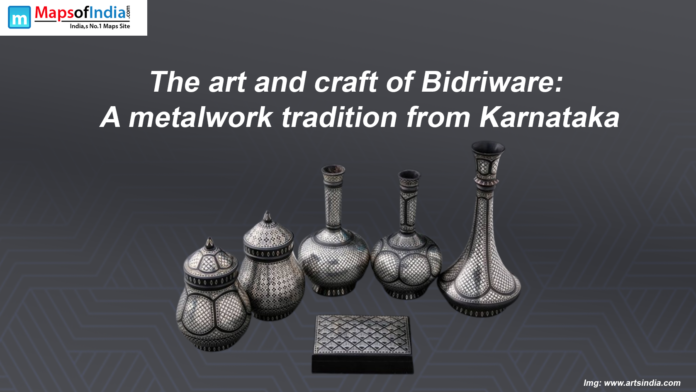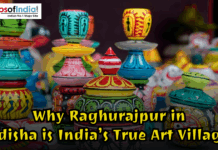Have you ever seen pieces of black metal decorated with intricate silver designs? This is a traditional metal handicraft termed Bidriware. It hails from Karnataka, a southern state in India. Bidriware has a long history and is a craft that has been passed down through generations of traditional artisans.
Historical Background
It was named after the city of Bidar in Karnataka and is known as Bidriware. In the 14th century, during the ruling period of the Bahmani Sultanate, Bidar served as an important capital city. During this time, the Sultan is believed to have patronised patronised the birth of Bidriware. The Sultanate rulers invited Persian and Syrian artisans to settle in Bidar and advance the metalworking technique. Afterwards, Bidar became one of the principal producing sites of Bidriware in India.
Unique Features of Bidriware
Then what is so special about Bidriware? The first is metal bases made from zinc alloy, and the second is inlaid silver work used by pure silver. The zinc alloy artisans create the initial shapes of bowls, boxes, vases, etc. The most complex task involves etching stunning patterns on the metal. Popular patterns include floral patterns and geometry from Persian and Indian art. Furthermore, baby strips or silver wires are hammered into those engravings.
Blackening Process
After moulding and engraving, the master craftsmen give the Bidriware the customary black shade. They rub the piece with a special blackening mixture made of soil, ammonium chloride, and water. The soil used originates from an ancient fort at Bidar, one of the most salt-rich regions. This procedure helps darken the zinc alloy foundation but conserves the silver inlay from becoming rusted. A final polishing with oil brings out the high contrast between the black and silver surfaces.
Metalworking Techniques
Bidriware Artisans have created many metalworking techniques throughout the years. The principal methods employed are ‘Uttarkashi’, in which silver wire is inlaid; ‘tarnished’, in which silver sheet is inlaid; and ‘garnish’, in which low relief carving is filled with silver. Oftentimes, craftsmen skillfully integrated several techniques in one piece. But today, products made of Bidriware are no longer limited to traditional containers but also include contemporary products such as lamps, laptop sleeves and much more.
Training and Artisans
Bidriware takes years of training to produce. The process involves casting, carving, polishing, and eight detailed stages to create the piece. We learn about the different teams of artisans who specialise in moulding, engraving, and the final blackening treatment. This tradition continues to this day and has been passed on through generations in Bidar. Among the renowned artisans was Shah Rasheed Ahmed Quadari, whose ability to preserve the technicalities of Bidriware was nationally recognised.
The Special Soil of Bidar Fort
Have you ever wondered what makes the soil from Bidar Fort so special for blackening Bidriware? Scientists say this is likely due to its high alkaline nitrate content. When it is rubbed onto the heated metal alloy, the nitrates react with copper to produce a thin black layer of copper oxide. This creates a unique dark patina known as the natural oxide patina of Bidriware, which is permanent. Discovering new blackening soils of similar behaviour is an ongoing issue for artisans today.
Bidriware Beyond Bidar
While Bidar remains an important centre, Bidriware is also made in other Indian cities like Lucknow, Murshidabad and Hyderabad. Each region has developed unique design styles over time. The craft has even spread overseas! Bidriware is displayed in exhibits worldwide, and collectors seek these objects of Indian artistry. Various state organisations now work to safeguard Bidriware’s status as a heritage craft through registrations and promotional initiatives.
To sum up, Bidriware is an excellent representation of India’s ancient metalworking traditions. A traditional form of black and silver hand imprinting in Karnataka, this unique handicraft has won the hearts of many abroad and at home over the past few centuries. So if you cross an Indian art exhibition next time, look around, you just might see his breathtaking piece of Bidriware art.




